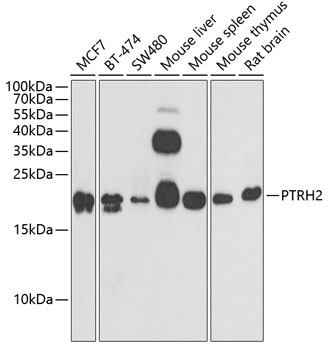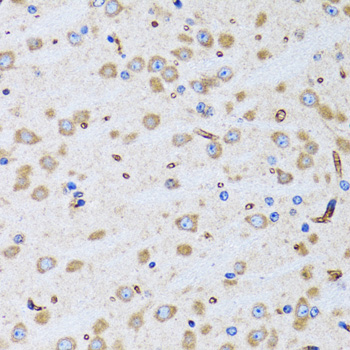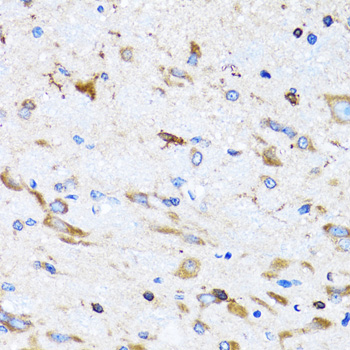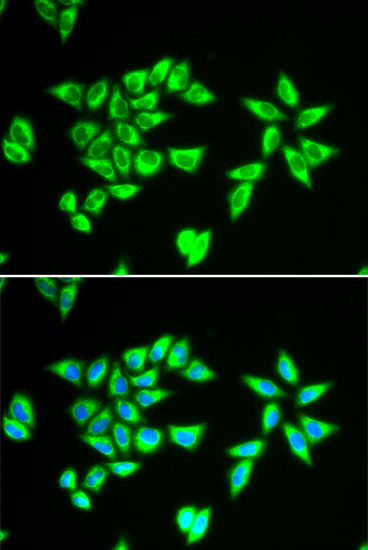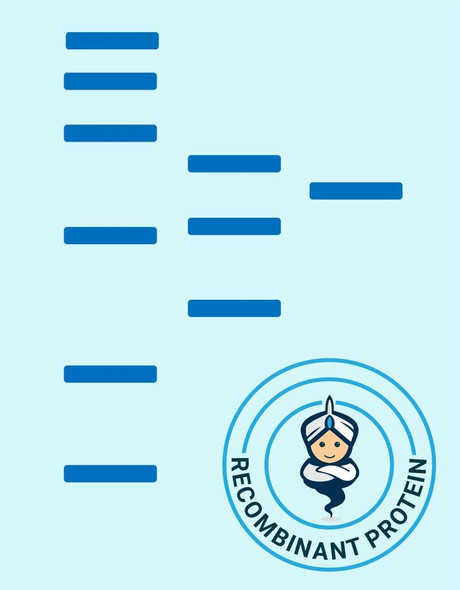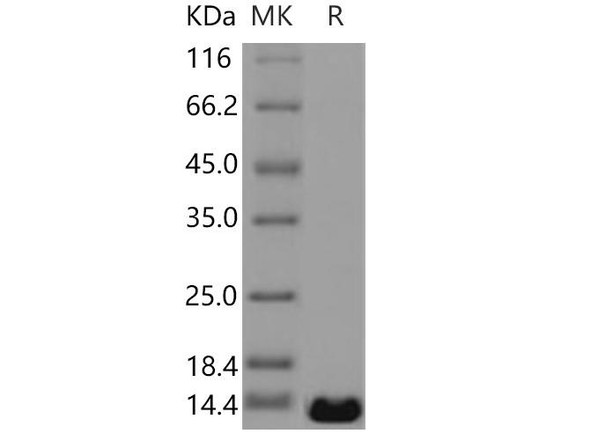Cell Death Antibodies 2
Anti-PTRH2 Antibody (CAB6466)
- SKU:
- CAB6466
- Product Type:
- Antibody
- Reactivity:
- Human
- Reactivity:
- Mouse
- Reactivity:
- Rat
- Host Species:
- Rabbit
- Isotype:
- IgG
- Antibody Type:
- Polyclonal Antibody
- Research Area:
- Cell Death
Description
| Antibody Name: | Anti-PTRH2 Antibody |
| Antibody SKU: | CAB6466 |
| Antibody Size: | 20uL, 50uL, 100uL |
| Application: | WB IHC IF |
| Reactivity: | Human, Mouse, Rat |
| Host Species: | Rabbit |
| Immunogen: | Recombinant fusion protein containing a sequence corresponding to amino acids 40-179 of human PTRH2 (NP_057161.1). |
| Application: | WB IHC IF |
| Recommended Dilution: | WB 1:500 - 1:2000 IHC 1:50 - 1:200 IF 1:10 - 1:100 |
| Reactivity: | Human, Mouse, Rat |
| Positive Samples: | MCF7, BT-474, SW480, Mouse liver, Mouse spleen, Mouse thymus, Rat brain |
| Immunogen: | Recombinant fusion protein containing a sequence corresponding to amino acids 40-179 of human PTRH2 (NP_057161.1). |
| Purification Method: | Affinity purification |
| Storage Buffer: | Store at -20'C. Avoid freeze / thaw cycles. Buffer: PBS with 0.02% sodium azide, 50% glycerol, pH7.3. |
| Isotype: | IgG |
| Sequence: | LPKS KTSK THTD TESE ASIL GDSG EYKM ILVV RNDL KMGK GKVA AQCS HAAV SAYK QIQR RNPE MLKQ WEYC GQPK VVVK APDE ETLI ALLA HAKM LGLT VSLI QDAG RTQI APGS QTVL GIGP GPAD LIDK VTGH LKLY |
| Gene ID: | 51651 |
| Uniprot: | Q9Y3E5 |
| Cellular Location: | Mitochondrion |
| Calculated MW: | 19kDa |
| Observed MW: | 19kDa |
| Synonyms: | PTRH2, BIT1, CFAP37, CGI-147, IMNEPD, PTH, PTH 2, PTH2 |
| Background: | The protein encoded by this gene is a mitochondrial protein with two putative domains, an N-terminal mitochondrial localization sequence, and a UPF0099 domain. In vitro assays suggest that this protein possesses peptidyl-tRNA hydrolase activity, to release the peptidyl moiety from tRNA, thereby preventing the accumulation of dissociated peptidyl-tRNA that could reduce the efficiency of translation. This protein also plays a role regulating cell survival and death. It promotes survival as part of an integrin-signaling pathway for cells attached to the extracellular matrix (ECM), but also promotes apoptosis in cells that have lost their attachment to the ECM, a process called anoikos. After loss of cell attachment to the ECM, this protein is phosphorylated, is released from the mitochondria into the cytosol, and promotes caspase-independent apoptosis through interactions with transcriptional regulators. This gene has been implicated in the development and progression of tumors, and mutations in this gene have been associated with an infantile multisystem neurologic, endocrine, and pancreatic disease (INMEPD) characterized by intellectual disability, postnatal microcephaly, progressive cerebellar atrophy, hearing impairment, polyneuropathy, failure to thrive, and organ fibrosis with exocrine pancreas insufficiency (PMID: 25574476). Alternative splicing results in multiple transcript variants encoding different isoforms. |
| UniProt Protein Function: | PTRH2: The natural substrate for this enzyme may be peptidyl- tRNAs which drop off the ribosome during protein synthesis. Monomer. Belongs to the PTH2 family. |
| UniProt Protein Details: | Protein type:EC 3.1.1.29; Mitochondrial; Hydrolase Chromosomal Location of Human Ortholog: 17q23.1 Cellular Component: membrane; mitochondrion; cytosol Molecular Function:protein binding; aminoacyl-tRNA hydrolase activity Biological Process: apoptosis; metabolic process Disease: Neurologic, Endocrine, And Pancreatic Disease, Multisystem, Infantile-onset |
| NCBI Summary: | The protein encoded by this gene is a mitochondrial protein with two putative domains, an N-terminal mitochondrial localization sequence, and a UPF0099 domain. In vitro assays suggest that this protein possesses peptidyl-tRNA hydrolase activity, to release the peptidyl moiety from tRNA, thereby preventing the accumulation of dissociated peptidyl-tRNA that could reduce the efficiency of translation. This protein also plays a role regulating cell survival and death. It promotes survival as part of an integrin-signaling pathway for cells attached to the extracellular matrix (ECM), but also promotes apoptosis in cells that have lost their attachment to the ECM, a process called anoikos. After loss of cell attachment to the ECM, this protein is phosphorylated, is released from the mitochondria into the cytosol, and promotes caspase-independent apoptosis through interactions with transcriptional regulators. This gene has been implicated in the development and progression of tumors, and mutations in this gene have been associated with an infantile multisystem neurologic, endocrine, and pancreatic disease (INMEPD) characterized by intellectual disability, postnatal microcephaly, progressive cerebellar atrophy, hearing impairment, polyneuropathy, failure to thrive, and organ fibrosis with exocrine pancreas insufficiency (PMID: 25574476). Alternative splicing results in multiple transcript variants encoding different isoforms. [provided by RefSeq, Mar 2015] |
| UniProt Code: | Q9Y3E5 |
| NCBI GenInfo Identifier: | 6686183 |
| NCBI Gene ID: | 51651 |
| NCBI Accession: | Q9Y3E5.1 |
| UniProt Secondary Accession: | Q9Y3E5,Q9NTE5, B3KUY4, |
| UniProt Related Accession: | Q9Y3E5 |
| Molecular Weight: | 179 |
| NCBI Full Name: | Peptidyl-tRNA hydrolase 2, mitochondrial |
| NCBI Synonym Full Names: | peptidyl-tRNA hydrolase 2 |
| NCBI Official Symbol: | PTRH2 |
| NCBI Official Synonym Symbols: | BIT1; PTH2; CFAP37; CGI-147 |
| NCBI Protein Information: | peptidyl-tRNA hydrolase 2, mitochondrial; PTH 2; bcl-2 inhibitor of transcription 1; cilia and flagella associated protein 37 |
| UniProt Protein Name: | Peptidyl-tRNA hydrolase 2, mitochondrial |
| UniProt Synonym Protein Names: | Bcl-2 inhibitor of transcription 1 |
| UniProt Gene Name: | PTRH2 |
| UniProt Entry Name: | PTH2_HUMAN |
View AllClose


